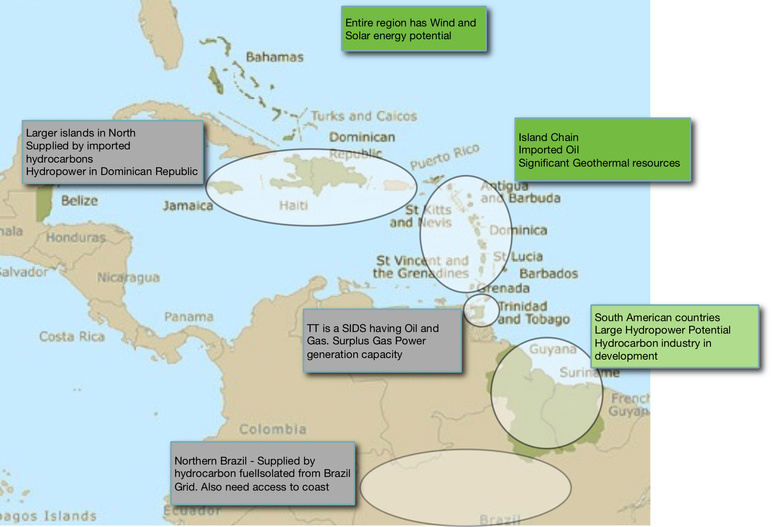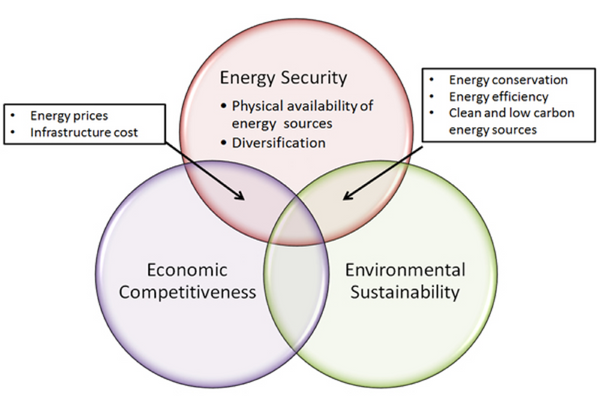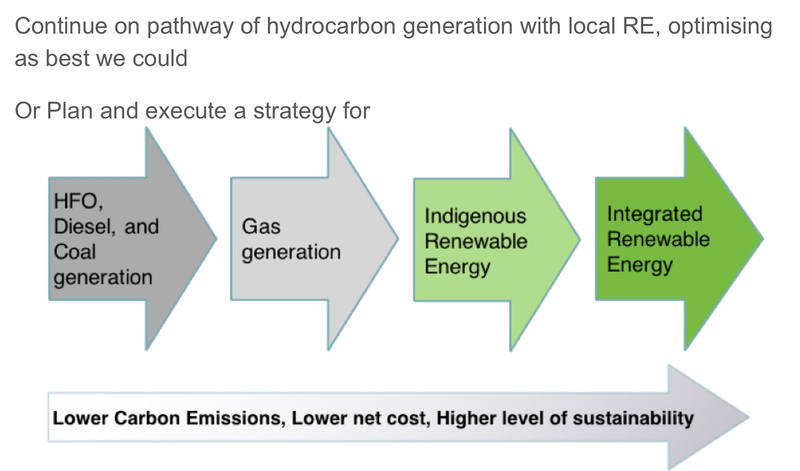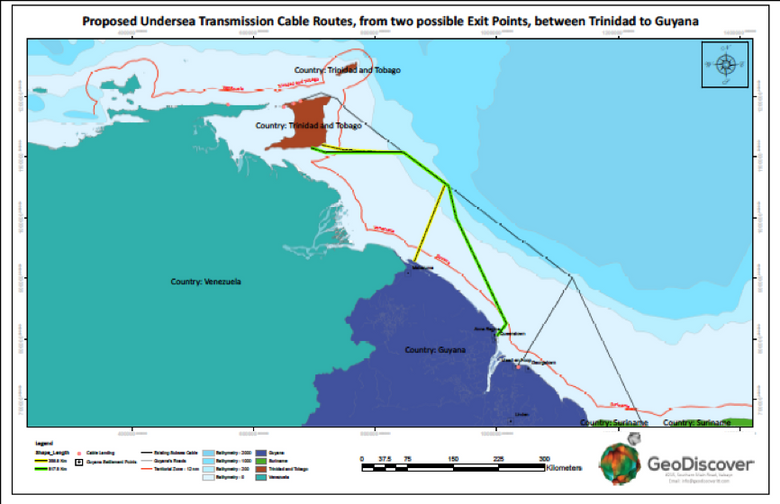

Integrating the Caribbean's Energy Markets - for lowest carbon emissions, highest resilience and lowest cost

Regional Energy Transition
The Southern Caribbean Cable Company Ltd (“SC3"), with its international partners, are developing a power and telecoms interconnection across participating Caribbean territories in an ambitious phased development. The design prioritises lowest carbon sources of power, utilising surplus gas power generation in Trinidad & Tobago to kickstart the development.
The project targets hydroelectric power in Guyana and Suriname and geothermal power from the volcanic island chain. Wind and solar will complete the renewable sources. The reservoirs in the hydropower facilities will serve as the "battery" storage, and gas power generation will meet gaps in supply. This project, using advanced technologies, such as High Voltage Direct Current (HVDC) and sophisticated Blockchain and AI based power dispatch software.
The system will be built by world-leading companies and financed as a Public Private Partnership at no cost to the Governments of participating countries.



The Southern Caribbean Cable Company (SC3)
is creating an economic model that addresses the triple challenges related to Environment, Energy and Economic Development in the region. The proponents have developed an ambitious and well thought out concept: an integrated energy market tied to new and improved economic activities in the participating territories.
Simply put, the project will see optimisation of renewable energy potential in the region, such that some countries produce - and others consume - the lowest cost, cleanest power at any given time and the power fosters new industrial development. The design includes a fibre optic cable which will provide low cost telecommunications.
The project is being developed in phases as Caribbean Governments choose. The intention is to start in Trinidad and Tobago where there is gas based power generation. World class technology is being employed. The multi billion dollar financing targets Energy Transition funding in a Public Private Partnership arrangement.
The Caribbean energy transition requires a carefully thought out progression from the use of carbon-producing heavy fuel oil, diesel. natural gas and some coal to 100% renewable energy (RE). RE resources exist, untapped. However, the capital cost is high and the market size limits the size of projects.
There is a strong case for Distribute Energy Resources i.e. wind, solar and hydropower in the local grids. The interconnection or "Super grid" adds the resilience, reduces cost and creates new developmental opportunities.

The Story
Donald Baldeosingh has been concerned about the Caribbean's energy future for more than 30 years. As Chair of Petrotrin, he recognised that the oil and gas base to Trinidad and Tobago's economy was not sustainable in the longer term. Also, that the Caribbean had to turn to its abundant renewable energy sources. At that time the drivers were cost of imported oil, and energy security. He conceptualised the Caribbean Power Interconnection as way to usher a new era of energy independence and prosperity for the region.
Nowadays, the main driver is the carbon cost of Caribbean power. The region must embrace energy transition to play its part in climate change mitigation. The benefits of reduced cost of energy, new business opportunities and more resilient economies are more important today.
We also recognise the challenges in achieving consensus among Caribbean countries in a short timeframe. However, there is a heightened sense of urgency, coupled with resource availability to achieve the energy transition. SC3 advocates a phased approach with a vision for a clean, resilient, affordable regional power system.
Addressing a session at the
UN Headquarters New York
on Sustainable Transport
in Small Island Developing States
2023 February
Biosketch
Donald Baldeosingh is an energy specialist and social entrepreneur. He is the Founder of the technology-based ENMAN Group and the non-profit Carbon Zero Institute of Trinidad and Tobago, CZITT. At CZITT, he leads projects in climate awareness and action. He developed a Roadmap to Net Zero Emissions for Trinidad and Tobago, and built a Caribbean e-learning platform based on Education for Sustainable Development.
Mr Baldeosingh worked in the local power, oil and gas industries and served as Chairman of the Petroleum Company of Trinidad and Tobago Ltd (Petrotrin), Trinidad and Tobago's national oil company.
He served for 10 years on the Industry Advisory Board to the American Society of Mechanical Engineers. Mr Baldeosingh has chaired conferences on such topics as Engineering, Procurement and Construction; Carbon Trading and Infrastructure Financing.
Mr Baldeosingh holds BSc and MSc degrees in Electrical Engineering from the University of the West Indies.

The project development follows a classic "Stage-Gate" approach moving through -
- Concept Development and Testing
- Engagement with Key Stakeholders
- Prefeasibility Analysis
- Full Feasibility Analysis, Bankable Report
- Financing Plan, Investors, Financiers
- Engineering, Procurement and Construction
- Start of Operation
Essentially, the project is in stages 4 and 5. The next investment tranche of $1m will be applied to complete these stages and lead the way to 6 and 7.
CAPEX runs from $250m to $2Bn for various Project Phases and the timeline is three to 10 years.
Contact us for more details..
Key Indicator | Activity / Project | Outcome |
Feasibility Assessment | Pre Feasibility Studies | Proven to be feasible at Pre Feasibility Level |
Engagement with governments | Meetings with and presentations to government agencies | Meetings with state officials and agencies with positive responses. |
Investment and financing | Settle on Shareholders and Financiers | Considerable interest from Financiers, more moderate from investors |
Selection of EPC contractors | Contracts with suppliers | Communication with suppliers for all aspects. No contracts. |

The SC3 core team led by experienced professionals and complemented by several international subject matter experts. We bring knowledge of regional culture, systems and players, international project financing and management, and a strong passion to engender the change needed.
robert shelton JD
Chairman
Senior Washington DC attorney with a track record in major infrastructure projects
President and CEO
Electrical Engineer with over 35 years in the State sector and regional energy business
Donald Baldeosingh
MSc
C-suite management expertise on a global scale for world-class, multi-billion dollar companies
Engineering Manager
Senior Engineering , Construction and
Project Management professional
Narayan Ramtahal MSc PMP




six steps to A CARIBBEAN SUSTAINABLE ENERGY FUTURE
1. PROBLEM STATEMENT
As Small Island Developing States, the region is seeing the effects of climate change: extreme weather events, sea level rise and reduced fisheries and food production. Covid-19 and the Ukraine war have increased the cost of imported oil for power generation and transportation, wreaking havoc on the economies.
The region needs to decarbonise, and build energy resilience.
2. DEFINE THE OBJECTIVES
- Clean, reliable and affordable electricity supply
- Maximum renewable energy, available to all
- Decarbonised power generation, transportation and industry
- Sustainable economic growth and prosperity
3. SELECT PATHWAYS TO THE GOAL
- Set aggressive net zero targets
- Replace hydrocarbon based power with renewable energy
- Create new climate-smart economic models
- Maximise indigenous energy, human and financial resources
- Export surplus low carbon energy

4. EXPLORE BOLD solutionS
Integrate the energy markets, making the lowest cost and lowest carbon energy available to all territories throughout the region.
Gas-generated power from T&T and Hydroelectric power from Guyana will provide the basis for the interconnection.
Hydropower dam will solve the energy storage problem.
Geothermal, wind and solar energy will increasingly complement
hydropower with gas generated power as back-up.
5. IDENTIFY RESOURCES
Technology for interconnecting power - and telecommunications - is mature and proven. Several world-class players are involved.
There is funding from private and institutional investors, multilateral agencies, donors and the Green Climate Fund.
The region has the human capital to partner with renowned specialists in the field.
6. PHASED IMPLEMENTATION
Export power from Trinidad to Guyana and/or Grenada using surplus generation capacity and stranded pockets of gas. Construct wind/solar/hydropower and economic zone in Guyana Connect Guyana to Brazil and Suriname.
Link the Caribbean Island chain, exporting Geothermal energy.
Include economic development programmes like the processing of indigenous natural resources, data centres, and crypto mining.
For more info. please email